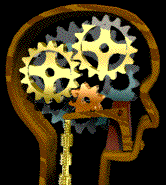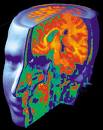Serendip is an independent site partnering with faculty at multiple colleges and universities around the world. Happy exploring!
Engaging the Whole Mind in Science Education

Inquiry for me: Pursuit of deep understanding within myself as initiated by curiosity that might be tested by materials but definitely (tested) by the opinion of my community.

Engaging the Storyteller and the Cognitive Unconscious in Science Education : SCALE
TEACHER
QUESTIONS:
What could be the focus of our presumptive development of student brains?
How can we maintain balance in our classroom so that all students feel relatively comfortable and have emotional stability through discovery and the “aha” experience?
Student
The Daily show: Pinky and the Brain?
If we engage the left and right brain of our students: will we decrease the mental area left over to create challenging behavior?
What has been said about Right-Brain Thinking?
Daniel Pink Revenge of the Left Brain
Logical and precise, left-brain thinking gave us the Information Age. Now comes the Conceptual Age - ruled by artistry, empathy, and emotion.
We've progressed from a society of farmers to a society of factory workers to a society of knowledge workers. And now we're progressing yet again - to a society of creators and empathizers, pattern recognizers, and meaning makers.
Logical, linear, analytic thinking remains indispensable. But it's no longer enough. To flourish in this age, we'll need to supplement our well-developed high tech abilities with aptitudes that are "high concept" and "high touch." High concept involves the ability to create artistic and emotional beauty, to detect patterns and opportunities, to craft a satisfying narrative, and to come up with inventions the world didn't know it was missing. High touch involves the capacity to empathize, to understand the subtleties of human interaction, to find joy in one's self and to elicit it in others.
The sorts of abilities that now matter most are fundamentally human attributes. After all, back on the savannah, our caveperson ancestors weren't plugging numbers into spreadsheets or debugging code. But they were telling stories, demonstrating empathy, and designing innovations. These abilities have always been part of what it means to be human. Daniel Pink
Your Thinking Cap

Thinking cap usually refers to our brain’s cerebral cortex — the grey matter that some neuroscientists consider the source of our thinking capacity.
There’s a common assumption that most of us are either right-brained OR left-brained. But if that’s true, then we must assume that the great scientific genius Albert Einstein was left-brained — and the great creative master of photography, Ansel Adams, would then have been right-brained.
But examinations of the notebooks of Albert Einstein and Ansel Adams pokes huge holes in this assumption. In fact, Einstein credited his greatest scientific insights not to left-brain logic — but to his right-brain highly creative daydreaming. Ansel Adams credited his greatest art photographs not to his right-brain artistic eye — but rather to his left-brain detailed analytical note taking.
When you describe yourself as primarily creative or intuitive (right-brained), or analytical and logical (left-brained), PERHAPS you are just describing the side of the cortex you have most successfully developed.
Is is it possible to actually develop a high performance, Enstein or Ansel Adams mind?
http://www.quantum-self.com/quantum-library/build-mind-power/whole-brain-thinking-andmind-power.html
Can we use models effectively to promote Thinking?
Light Shed On How The Brain 'Thinks'
by Kate Melville
by Kate Melville

Think of a milk bottle, solid white and apparently full of milk, standing on a shelf. In order to pick it up, the brain sends a signal to the arm and hand to lift the bottle, making presumptions about how much the bottle weighs so sufficient force can be utilized. If the presumptions are correct, the procedure works flawlessly. But what if the bottle is only painted white, is actually empty? The hand, expecting it to weigh more, uses too much force and the bottle goes flying.
This shows that humans use internal models of reality to guide movements. The change in the program is the equivalent of secretly replacing the full milk bottle with an empty, lighter one. The subject working the robot-arm decides how to modify the much-altered model of reality. The paper describes mathematically how that happens.
First comes the process of unlearning the old paradigm before learning the complex new one. The subject has to think: "If I make my next movement, how will that affect my other movements? You changed the world for me; I see errors. If the errors are big enough, I have to reconsider the entire model." The next move the subject makes likely is worse than the one before until the subject starts realigning the primitives correctly.
Experiments show that the theoretical limits are closely observed in people's learning abilities. In other words, humans have a limited number of primitives to deploy when learning skills. http://www.scienceagogo.com/news/20000916042208data_trunc_sys.shtml






